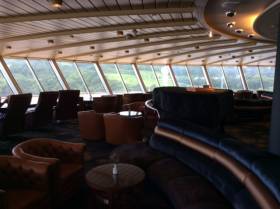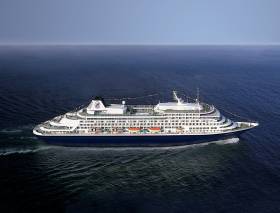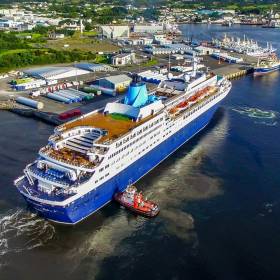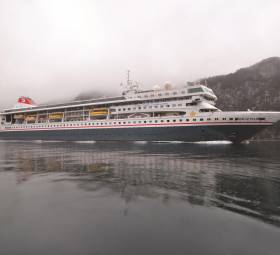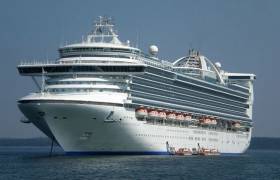Displaying items by tag: Cruise Liners
Liverpool Approves Feasibility Study for New Cruise Terminal
#ProposedTerminal - According to CruiseEurope authorities in Liverpool last month approved a £950,000 (€1.12m) feasibility study into a proposed new cruise terminal development.
The west coast UK port has long held ambitions to expand its offer with the construction of a purpose-built facility capable of attracting additional turnaround business and handling up to 3,600 passengers.
Afloat.ie adds that the proposed development has already led to the Manx Government voting that a site be acquired as the existing Isle of Man ferry berth would need to be relocated for the new development.
Liverpool’s existing cruise berth opened nine years ago with the aim of securing day calls. A temporary passenger facility was subsequently added in 2012 and the city now attracts turnaround as well as transit business. The River Mersey terminal is this year scheduled to handle 61 vessels and 76,000 passenger who are able to disembark directly onto the city’s world famous, UNESCO World Heritage Site waterfront.
A report to the City Council’s ruling Cabinet set out the next steps in the development plan and the need for detailed investigations, impact assessments and surveys. Councillors gave the go-ahead to the work which will be led by a consortia of technical specialists including Ove Arup & Partners, Royal Haskoning DV, Tuner and Townsend and KKA Architects.
A footprint for the planned development has already been identified. It will require demolition of a former timber landing stage, which once handled Liverpool’s transatlantic services until the late 1960s, and construction of a platform in the river to accommodate the new terminal. It is envisaged that this building will be on two levels built on reclaimed land.
Mayor of Liverpool Joe Anderson said: “I am determined that we find solutions to continue the growth we have seen in cruise business. What is holding us back at the moment is the limited space we have in the existing facility. To deliver on our ambitions, we would need to invest in a new terminal building which will bring bigger liners carrying more passengers, meaning a bigger boost for the local economy.”
Liverpool’s 2016 cruise schedule is estimated to generate an income of £6.5m (€7.7m) for the city’s economy. Mayor Anderson added: “We have various options of funding the scheme which we will be exploring, but the figures speak for themselves in terms of jobs supported and created by passengers and crew spending money when they visit the city.” Timescales for the phase of work approved today have not yet been set.
On July 2 the centenary of one of Liverpool’s Three Graces, the Cunard Building was celebrated. To mark the occasion that morning, Queen Elizabeth sailed up the River Mersey heralding the start of a series of events marking the centenary of this iconic venue. These included two ‘Best of British’ celebratory concerts which took place on the world heritage waterfront at Pier Head.
The weekend also saw the Cunard Building opening its doors to a brand new exhibition charting the rise and success of The Jam. With more plans in the pipeline, the Cunard Building is once again opening for the public.
In June Disney Magic (see first ever call by Disney Cruise Lines to Dublin Port) was met by 100,000 people on Liverpool Pier Head. Adults and children dressed up in Disney outfits for a day of Disney-themed activities to celebrate the ship’s return to Liverpool for the second time. Disney Magic returns in 2017 when the city will repeat the event as a result of the positive feedback from those attending.
Fred Olsen is offering a total of 16 sailings from Liverpool in its 2016 cruise season. Head of sales Neil Herbert commented: “Fred Olsen is a frequent visitor to the Merseyside region and in 2016 is offering one of the highest number of cruise calls, allowing guests from the North West a greater choice of destinations and holiday duration.”
Holland America Line Makes Homage Atlantic Anchorage
#GalwayAnchorage – Holland America Line’s Prinsendam continues her 28 Day Celtic & Bourgundian Explorer Cruise with an anchorage call on Galway Bay today, writes Jehan Ashmore.
Prior to the cruiseship's arrival off Galway Port, Prinsendam so far has visited Dublin, Belfast (as reported), the Scottish western isles and Killybegs yesterday.
She has a capacity for 766 passengers and 460 crew and in which cruisegoers are been tendered ashore to the City of the Tribes. The US company founded in 1928 has a history of trans-Atlantic 'liner' calls taking anchorage in Galway Bay.
During the careers of their Maasdam and Ryndam this required the use of a dedicated liner tender, Calshot which HAL purchased in 1964 through a subsidiary, Port & Liner Services (Ireland) Ltd.
Prinsendam is the final caller out of six cruiseships this season, however Galway Harbour Company have scheduled in for 9 calls in 2017. Again this will include HAL's Prinsendam, at 38,848 gross tonnage which is deemed small these days. Much larger cruiseships are planned as the port have proposed an outer deeper water port which would not require anchoring off Mutton Island.
In the meantime, at the entrance to Galway on the outer pier is where a fleet of the cruiseships tenders are ferrying visitors back and forth. On the adjacent berth is LastMara Teo’s freight-only Aran Islands serving vessel, Bláth na Mara, whose fleetmate Chateau-Thierry transported generators from Rossaveal during power cuts on two of the three islands.
Also berthed but alongside the quays of the Claddagh area is the former Commissioners of Irish Lights Dun Laoghaire Harbour based buoy-towage tender Puffin.
The Bristol built tug retains its original name having been acquired in 2011. Afloat two years later made a trip on board Puffin, which also carries out ship mooring lines-boat duties along the Shannon Estuary. On that occasion, this involved a repositioning passage from the Rusal Aughinish Alumina plant jetty to the Port of Foynes.
US Luxury Sail Assisted Flagship Bids Dun Laoghaire Farewell As Last Cruiseship of 2016
#FinalCaller – Five masts, each 221ft towered above Dun Laoghaire Harbour’s Carlisle Pier as US luxury operator, WindStar Cruises motor sail-assisted flagship Wind Surf made the last call of the season, writes Jehan Ashmore.
The 14,000 gross tonnage Wind Surf had made a cruise turn around in the south Dublin Bay harbour. With a 312 capacity, Wind Surf was among eight callers this year bringing around 10,000 tourists and crew to the harbour's hinterland and visitor attractions.
In fact, Wind Surf has been the most frequent visitor since Dun Laoghaire welcomed back cruiseships on a more concerted basis that began in 2011. The cruiseship business is the only commercial shipping sector since Stena Line withdrew their HSS fast-ferry service to Holyhead, Wales in 2014.
WindStars customers arrived at Carlisle Pier to board Wind Surf that departed yesterday evening, it was observed the departure involved a pilot cutter from Dublin Port to guide the vessel into the bay. While at the same time some of her self-furling computer operated sails were unveiled.
The cruise first port of call is an anchorage visit off Dunmore East today on the Waterford estuary. She then heads for Tresco, Scilly Isles, Brest, France, followed by a day at sea in the Bay of Biscay bound for Ferrol and Vigo in Spain, Leixoes in neighbouring Portugal and culminating in the capital, Lisbon. From thereon, Wind Surf returns to her programme of Mediterranean cruising.
According to DLHC a variety of cruise calls from vessels holding 100 to almost 3,000 passengers arrived from the newly refurbished Hebridean Sky to the larger newcomer, TUI Cruises Mein Schiff 1 that anchored offshore aswell as Celebrity Silhouette, which made an appearance last year.
Six out of the 8 cruise ships visiting this summer berthed alongside Carlisle Pier from where passengers had the short stroll to the town centre.
Welcoming visitors to the town were Dun Laoghaire County Council town ambassadors and volunteers from the DLR Volunteer centre that created a great atmosphere.
Carolyn Hanaphy of Dun Laoghaire Harbour today said “We await the planning decision from An Bord Pleanala about our proposed cruise berth, such that we can attract over 100,000 cruise passengers per year.”
The season for 2017 will see half the total of callers, when four calls are scheduled by two cruiseships. Again they will be made by repeat cruise clients, WindStar represented by their Wind Surf and Star Legend.
HAL Visits Belfast On Celtic & Bourgundian Explorer Cruise
#HALcall – Holland America Line’s Prinsendam berthed in Belfast Harbour this morning as part of a 28 Day Celtic & Bourgundian Explorer Cruise, writes Jehan Ashmore.
This was the second call of HAL's Prinsendam to Belfast this season as she called in July. Overall, this morning's call was her 14th visit to the port having berthed at the Stormont cruise wharf. She has a capacity for more than 766 passengers and 460 crew.
Prinsendam at under 40,000 gross tonnage is the smallest of the HAL fleet which now has a newcomer, Koningdam, just shy of 100,000 gross tonnage. She was named in May as the first of the 'Pinnacle' class, the largest ever built for the US based operator, part of the Carnival Corporation. The newbuild can take a maximum of 3,200 passengers and over 1,000 crew.
Today’s call of Prinsendam represents the 29 caller and last of this month alone to Belfast. Asides, HAL, among the cruise operators they include Princess, Celebrity, Cunard, Silversea, Majestic, and Fred Olsen.
The port is to host almost 145,000 cruise visitors this season as the harbour is the principle gateway to the attractions of city and Northern Ireland.
Prinsendam had set off from Dublin, where she overnighted at Ocean Pier, within Alexandra Basin, where another fleetmate, Rotterdam had called earlier this month.
Saga's Northern Adventure from Donegal to Down
#CruiseNorth – Saga Cruises, part of the wider Saga brand that caters for UK consumers over 50, has been calling to ports in counties, Donegal and Down, contributing to boosting tourism in these northern regions, writes Jehan Ashmore.
The caller on the Wild Atlantic Way seaboard at Killybegs, was that of Saga Sapphire, one of the most elegant looking cruiseships docked on Wednesday. The 752 capacity cruiseship was assisted into Killybegs by Sinbad Marine’s tug, SMS Cian. Cruisegoers visited attractions among them Glenveagh National Park.
On the Irish Sea, Saga Cruises visit to Warrenpoint, is where the more intimate fleetmate, Saga Pearl II with just 449 passengers, visited last month according to Point Shipping Services.
The cruises are part of Hidden Britain itinerary, to visit never before ports of call, outside that of the mainstream cruise destinations that invariably are larger ports located in towns and cities.
Saga Pearl II returned to Carlingford Lough as the sole caller this season, having made a historic Warrenpoint call as the first ever cruiseship to dock at the port at the foot of the Mourne Mountains in 2014. The scenic coastal area is been promoted as a destination by Warrenpoint Harbour Authority and CruiseWarrenpoint.
Saga Sapphire represented the 10th caller out so far to dock in Killybegs out of the season’s total of 12 callers scheduled. The fishing and energy sector port has seen the cruise sector expand in recent years thanks to the Killybegs Information Centre, a development of Donegal Tourism.
Next to call is Holland America Lines smallest cruiseship, Prisendam with a 835 capacity on 1st September. Ending the season is left to Fred. Olsen Cruise Lines graceful, Boudicca and with a similar passenger total of 880 and which is to call a week later.
Biggest Cruise Caller to Welsh Ferryport of Fishguard
#BiggestCaller - Welsh ferryport of Fishguard which is managed by Stena Line which operates to Rosslare (see rare call), also welcomed the largest cruiseship ever to the Pembrokeshire harbour.
The German cruiseship AIDAVita dropped anchor last Thursday, writes Milford Mercury, and is 202 meters long, weighing 42,290 tonnes and has a capacity for 1,260 passengers.
AIDAVita was able to visit Fishguard following infrastructure improvements which were funded through the Welsh Government’s Tourism investment Support Scheme.
The project received £147,598 to provide a pontoon facility to accommodate the safe embarkation/disembarkation of passengers from cruise ships at anchorage in Fishguard Port.
The cruise ship market is big business for Wales – and Cruise Wales and partners are working to grow the market.
An increasing number of visitors from Germany are coming to south west Wales through cruise ships docking at Milford Haven Port, Pembroke & Fishguard.
Some 59 ships will stop in Wales this year which is a 20% increase on last year.
The cruise industry is worth £2.9 million to the Welsh economy. The paper has more here.
Two Cunarder "Queens" to Visit Donegal
#CunardDonegal - Two of the most famous names in British royalty are coming to Donegal - but it’s not members of the royal family; rather, it’s two massive 'Vista' class cruise ships named “Queen Elizabeth” and “Queen Victoria”!
The famous Cunard Line writes Donegal Now, has confirmed that two of its prestige 90,000 gross tonnage cruiseships will visit Killybegs in 2018 as part of two new cruise itineraries.
Both vessels are almost 300 metres long – more than twice the length of Croke Park!
The announcement is yet further evidence that Killybegs is now really making a name for itself as a cruise ship port of call.
“This is a good news story for Killybegs and for Donegal,” commented Anne Dorrian of the Killybegs Tourism Information Centre.
The tourism spin-off is considerable, with many of the passengers going on local tours and taking in attractions such as Slieve League and Glenveagh National Park as well as visiting the likes of Donegal Town.
Meanwhile, the Fred Olsen line has become the first cruise line to enable passengers to embark in Killybegs. In September passengers will be able to go on board the "Boudicca" on the "Rugged and Rural Canada" cruise to Newfoundland, Canada and back.
For details of the cruise and more, Donegal Now has a report here.
Cruiseship's Second Inaugural Irish Sea Port of Call
#CruiseFirsts - Irish Sea port of Barrow-in-Furness, operated by Associated British Ports / ABP Ports welcomed the largest cruise vessel ever to call to the Cumbrian port in north-west England.
MS Braemar became the second cruiseship to visit Barrow in the last two months, when the Fred. Olsen Cruise ship made an inaugural call last Friday. The 196m in length cruiseship which too made a first call to Rosslare Europort last month, can accommodate over 900 passengers, making it the largest cruise ship to visit since the port’s first cruise call in 1995.
While cruise ships are today not a regular sight at the Port of Barrow, the port has a long association with the industry dating back 100 years, including when the then Vickers-Armstrongs shipyard built the ‘Strath’ Class Liners for the Peninsular & Oriental Steam Navigation Company (P&O) in the 1930s.
Port Manager Paul Jervis said: “The Port of Barrow is best known today for its role as a base for manufacturing submarines. However, the arrival of MS Braemar, following the visit of the Saga Pearl II last month shows that the port is capable of handling a wide variety of vessels for different customers.
“The benefit of hosting cruise vessels here at Barrow is that we are able to showcase Barrow and the Lake District area to tourists from all over the UK and the world. It boosts the region’s profile and tourist numbers, and will provide economic benefit to the local communities.
“The area has a lot of attractions to entice cruise companies and their passengers. With the port well equipped to handle cruise calls, we hope to see more cruise ships at Barrow in the future.”
Scheduled shore excursions included tours of the Lake District and free shuttle buses available to take passengers to local attractions like the Dock Museum and Furness Abbey.
Plans for New €15m Berth to be Cobh’s Quay to Success
#NewBerth - A new €15m deep-water quay in Cobh is in the planning by the Port of Cork, to handle the increasing number of large cruise liners expected to arrive in the near future.
The Irish Examiner writes the port company have confirmed a record 66 liners are already booked to dock in the harbour next year, and the figure could well top 70 as the larger Quantum class vessels may yet announce their intention to visit.
The scheduled 66 ships will carry 170,000 passengers in total and, on average, they are expected to directly spend €73 each while ashore bringing a potential boost of €12.41m to the local economy.
Port of Cork commercial manager Captain Michael McCarthy said the company was planning to reach a target, by 2020, of attracting 75 cruise ships annually but it could be achieved earlier as business prospects are very encouraging.
The newspaper details more about the new cruise-berth here
Inquiry As to Why Cruiseship Lost Power In Irish Sea
#Inquiry - An investigation has been initiated by Bermuda, writes Irish Times, into how a “mega-class” cruise ship with almost 4,500 people on board spent nine hours drifting without power in the Irish Sea
As reported on Afloat earlier this month, the 290-metre Caribbean Princess was forced to abandon a scheduled visit to Dublin Port after the serious incident occurred 25 miles southeast of the capital off the Wicklow coast on August 3rd.
The 17-deck ship eventually regained power that evening and made its way to Belfast port, where it berthed in the early hours of August 4th.
Bermuda, the British overseas territory which is the port of registry for the ship, said it had continuously monitored the vessel’s situation “from the time of its propulsion failure until the full propulsion power was restored and its voyage to Belfast completed”.
The Bermuda Administration said it had been in “constant communication” with the British Maritime and Coastguard Agency on the incident. Holyhead Coast Guard despatched a tug and helicopter to the ship, which had 3,306 passengers and 1,158 crew on board when it lost power on its route up the Irish Sea. The ship had been en route from Cobh to Dublin as part of a 12-day cruise from Southampton.
For more on the incident, the newspaper has more here. Afloat adds the cruiseship is today docked in Dublin Port, having called to Cobh, Cork Harbour.




























